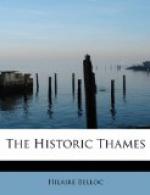But with the towns the case is different. There, except for the minimum of population, we are quite at sea. We may presume that the houses numbered are only the houses paying tax, or at least we may presume this in some cases, but already the local customs of each town were so highly differentiated that it is quite impossible to say with certitude what the figures may mean. It is usual to take the taxable value of the place to the Crown and to establish a comparison on that basis, but it is perhaps wiser, though almost as inconclusive, to consider each case, and all the elements of it separately, and to attempt, by a co-ordination of the different factors given to arrive at some sort of scale.
Judged in this manner, Wallingford and Oxford are the early towns of the Thames Valley which afford the best subjects for survey.
Wallingford in Domesday counted, closes and cottages together, just under 500 units of habitation. It is, of course, a matter of conjecture how much population this would stand for. A minimum is here, as elsewhere, easily established. We may presuppose that a close, even of the largest kind, was but a private one; we may next average the inhabitants of each house at five, which is about the average of modern times, and so arrive at a population of 2500. But this minimum of 2500 for the population of Wallingford at the time of the Conquest is too artificial and too full of modern bias to be received. Not even the strongest prejudice in favour of underrating the wealth and population of early England, a prejudice which has for it objects the emphasising of our modern perfection, would admit so ludicrous a conclusion. But while we may be perfectly certain that the population of Wallingford was far larger than this minimum, to obtain a maximum is not so easy. We do not know, with absolute certainty, whether the whole of the town has been enumerated in the Survey, though we have a better ground for supposing it in this case than in most others. Such numerous details are given of holdings which, though situated in the town, counted in the property of local manors that we are fairly safe in saying that we have here a more than commonly complete survey. The very cottages are mentioned, as, for example, “twenty-two cottages outside the wall,” and their condition is described in terms which, though not easy for us to understand, clearly signify that they could be taken as paying the full tax.
The real elements of uncertainty lie, first in the number of people normally inhabiting one house at that time, and secondly, in the exact meaning of the word “haga” or “close.”




